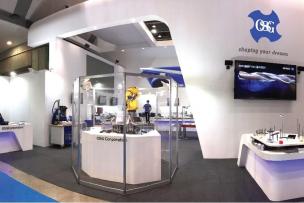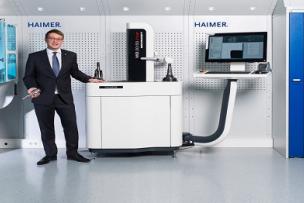Connect the Dots Between the Internet of Things and Your Shop
Industrial IoT technologies can help an organization gain a competitive advantage.
Metalworking has traditionally revolved around one person crafting specific parts or components—which eventually become a portion of a larger machine or system. But in Industry 4.0, an era dominated by rapidly advancing technology, that work is becoming far more interconnected. The industrial internet of things (IIoT) and the internet of things (IoT) both harness technology that connects machines, devices and data from sensors, allowing for communication that can observe, evaluate, accumulate and achieve a number of results without human intervention.
IoT systems tend to include consumer-based “smart” devices like your car, television or home-security system. The IIoT, however, involves a more sophisticated, reliable network of sensors and machines connected by the internet and controlling critical infrastructures. While the IIoT can provide reliability and efficiency in automated processes, it is still being defined and developed. In fact, most machine shops have yet to fully incorporate the level of connectivity required of IIoT to optimize machine operations, allowing for complete automation.
Tim Shinbara, vice president of technology at the Association for Manufacturing Technology, has firsthand knowledge of how these changes are affecting the industry. “There is enormous pressure on organizations to perform faster and better. The industrial internet of things addresses the needs of manufacturers by delivering crucial data and information when and where it’s needed,” Shinbara says. “By connecting multiple devices and systems, it’s possible to improve efficiency and lower costs.”
According to a recent LoSasso Integrated Marketing survey, about 80 percent of shop floors in the U.S. have internet access, and many manufacturing companies already have management software such as enterprise resource planning and other applications in place to help organize and automate business functions. But these systems do not necessarily provide the level of information needed to run a manufacturing company in the digital age. Instead, organizations prefer to have an accurate view of their materials and inventory at any given moment.
The Industrial Internet of Things Goes Beyond Computing
The industrial IoT also encompasses cloud computing, mobile technology, conventional computer networks and other methods to stream data into computer systems, where it can be used for machining or human decision-making.
“Businesses that use the industrial IoT gain real-time intelligence. It helps them achieve insights and capabilities that often lead to a competitive advantage,” says Abhijit Kabra, managing director at Accenture Mobility, part of consulting firm Accenture.
As the pace of digital change accelerates, Shinbara says metalworkers and others cannot afford to be left behind. “By incorporating embedded processing using sensors, smartphones, machine data and other systems, it’s possible to gain insights that weren’t possible in the past,” he says. “This may also include understanding when a machine requires maintenance in order to avoid breaking down or viewing materials from suppliers in real time, so that it’s possible to achieve lean inventory while avoiding running out of key commodities or components.”
Innovations in technology that use the IoT aren’t relegated to consumer trends. Data streaming from intelligent machine controllers, sensors on products, objects tagged with RFID (radio frequency identification), smartphones, tablets, Bluetooth and other wireless-connected tools can also help workers on the shop floor. RFID can assist with instantly locating and tracking items in a vast warehouse and through production so customers have real-time insight into orders. Industrial IoT technologies can also improve safety on the job by monitoring people, conditions and machines. An added bonus is that it provides an improved level of communication with the entire supply chain, including vendors and suppliers. “The possibilities expand daily,” says Shinbara.
The Industrial IoT Connects to Results
The ability to connect data and make it accessible raises an organization’s collective IQ, creating a smart factory. “It’s possible to produce products faster, more efficiently and at a lower cost point,” says Kabra. For instance, when an organization tags materials and inventory using RFID, it’s possible to view what’s on hand—and locate it—instantly. The same organization can place orders as soon as material and components hit a critical level.
But gaining a competitive advantage from the industrial IoT doesn’t just happen—and there are security concerns to address, including the possibility of hackers and attackers breaking into systems, sabotaging components and stealing data. Like any initiative, the IoT requires both business and IT acumen. These talents will help identify opportunities and potential improvements, including better ways to integrate various IoT components and ensure they work smoothly.
And for some, connected systems may not be the right choice for their businesses. It may be too complicated or costly, at least for now, or it might generate data that don’t benefit a manufacturer. Shinbara suggests first investigating these technologies and understanding how they can benefit your company. This makes it possible to move forward at the right time—and with the right strategy in place.
The end goal, Shinbara says, is to create greater value for the organization, supply chain partners and customers. For companies lacking the internal savvy and expertise to wade into industrial IoT or IoT technologies, he suggests seeking out external expertise. Although consultants are widely available, industry associations and local universities and community colleges tend to offer affordable access to knowledge and expertise. In addition, the National Network for Manufacturing Innovation, recently rebranded Manufacturing USA, can connect companies to innovation institutes that deliver specialized technology information and the ability to interact with peers.
“The industrial internet of things represents the future of business,” explains Shinbara. “It’s something that manufacturing firms and metalworking companies cannot afford to ignore.”
- The fundamental differences in manufacturing between industrial IoT and IoT.
- Investing in connecting data raises a company’s profile.
- Manufacturing USA connects people, ideas and technology to help solve challenges involving advanced manufacturing.
How have you incorporated the industrial IoT on your shop floor?




Talk to Us!
Leave a reply
Your email address will not be published. Required fields are marked *